|
Built and integrated by state-run Mazagon Dock
Ltd. (MDL), the 142.5 metre long, 6200 tonne Shivalik
class frigate has low radar signatures and a highly
advanced Electronic Warfare (EW) suite from BEL
(Bharat Electronics Ltd), another state-run defence
equipment manufacturer.
The warship was commissioned by Chief of the
Naval Staff, Admiral Nirmal Verma, who described
the vessel among the most modern in the world
with multi role area and point defence capabilities
and a big step towards India’s indigenous
ship building capability. All the three vessels
in the Shivalik class are designed by the Indian
Navy’s own design team, but each one is set
to have a better systems fit than its predecessor.
There are plenty of new features on board actually,
as the Indian Navy is working towards seamless
integration of its entire fleet and creating platforms,
sensors and weapons for effective defence of Indian
interests within the first half of the current
century. Some years later, new designs based on
new trends and developments, would help lay the
foundation stone of the newer class of ships required
from around 2040 or 2050 onwards.
But till then, there would be periodic refits
and every time a vessel is decommissioned, there
would be a newer class to replace it.
INS Satpura is designed to deflect radar, infra
red and acoustic signatures.
The first frigate in the series, INS Shivalik,
was inducted by the Navy in April 2010 and the
third and last in this class, INS Sahyadri, will
be commissioned in 2012. INS Satpura has the Indian
Navy number F 48, and its production is part of
Project 17.
The INS Satpura ceremony began with a ceremonial
inspection of a Guard of Honour by the Chief of
Naval Staff, and then an address by MDL Chairman
and Managing Director Vice Admiral H S Malhi.
After that, the vessel’s Commanding Officer
Captain Sharat Mohan read out its Commissioning
Warrant, handed over to him by Admiral Verma.
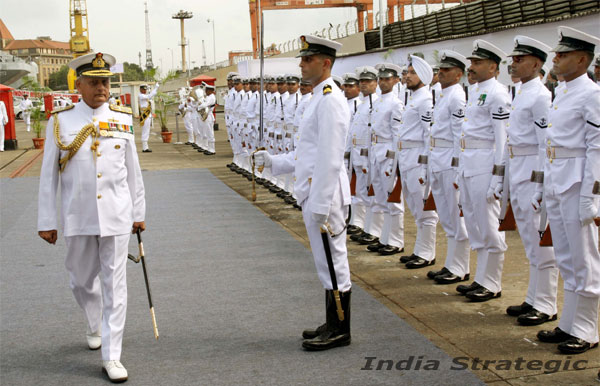
Captain Mohan then had the privilege of unfurling
the Indian Tricolour, the Naval Ensign and the
Commissioning Pennant, and later, hosting the
first reception on board INS Satpura. He promised
to live by the ship’s motto: Resolve, Pride
and Courage in defence of India.

The naval Chief personally met with the ship’s
officers and personnel and congratulated them
at the ceremony.
“I wish the crew fair winds and following
seas,” the naval Chief said as stated traditionally
by naval commanders for a vessel going on voyage.
According to Adm Verma, “each ship would
be progressively more modern than its predecessor,
and that INS Satpura already has better warfare
systems than INS Shivalik.”
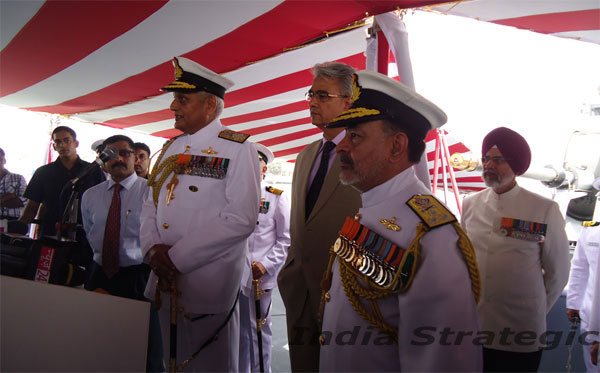
Pointing out that the Indian Navy “remains
committed to ensuring the security of sea-farers
in our region,” and that “India’s
destiny to take her rightful place amongst the
top economies of the world is inextricably linked
with ensuring unhindered global trade in a secure
maritime environment,” the Admiral described
the commissioning of the vessel as another “decisive”
step in that direction.
He emphasized: This state-of-the-art frigate
has been conceived and designed by the Navy’s
own design teams. With this landmark step, we
have come a step closer towards realization of
our long cherished dream of being self sufficient
in warship production. This dream has been relentlessly
pursued over the last four decades, since we first
undertook the production of indigenously designed
warships. We fully realise and are conscious of
our responsibility to the global maritime community
to ensure the safety of the international shipping
lanes that criss-cross our regions of interest.
Defence Secretary S K Sharma, Commander in Chief
of the Western Fleet Vice Admiral D K Joshi, Chief
of Staff of the Western Naval Command Vice Admiral
Pradeep Chauhan, Western Fleet Commander Rear
Admiral Girish Luthra and other top officers attended
the inspiring ceremony.
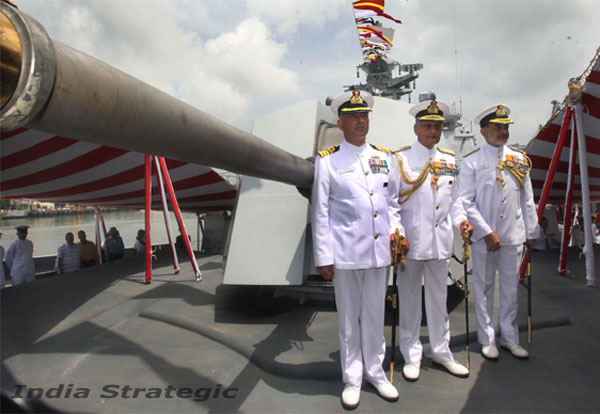
INS Satpura was scheduled to be commissioned
by Defence Minister A K Antony but he could not
come due to some illness.
Said Adm Verma: “The commissioning of INS
Satpura will strengthen the fighting fleet of
the Indian Navy. Its improved survivability, maneuvering
and stealth ability will act significantly towards
the Indian Navy’s status as a blue water
navy.” he added though that the Indian shipyards
had to cut down time in building ships.
Work on INS Satpura, named after a range of hills
in Central India, began in 2004, and the Navy
and other organizations involved in the ship building
programmes are now trying to cut down this time
by a year or two to international standards of
four to five years. Part of the problem the Indian
shipyards face is the lack of timely availability
of certain components, including special steel
which so far has been imported from Russia.
For INS Satpura, it has been developed by the
Defence Research and Development Organisation
(DRDO) and provided by an Indian manufacturer.
Significantly, except for submarines, the special
steel is now to be produced indigenously.
Nearly one-third of the cost of the warships
is due to some of the sophisticated imported systems
and special steel still not available within the
country.
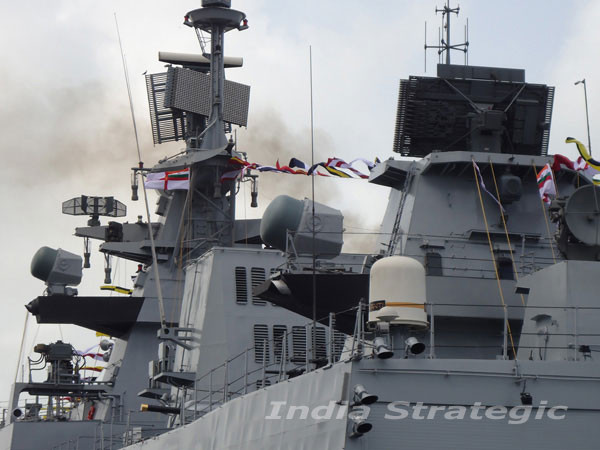
On the production of the warships, Vice Admiral
Malhi told India Strategic that
the company personnel did a great job by integrating
a number of indigenous and imported components,
sources from different companies and different
countries.
Literally standing tall and erect with pride,
he admitted some delay but said: “It is not
an easy job but MDL was virtually like a marriage
bureau for electrical, electronic, mechanical,
software and operational integration of US gas
turbine and French diesel engines, Russian and
Israeli missiles, Italian naval artillery gun,
and several other systems.”
INS Satpura has Russian Klub anti-ship and Shtil
anti-aircraft missiles, Israeli Barak air defence
missiles, Italian 76 mm Oto-Melara rapid fire
gun, Russian and Indian radars, Indian DRDO-provided
Kavach chaff firing system, and DRDL-BEL ECM and
EW suites besides anti-submarine rockets and other
Indian and imported sensors and components.
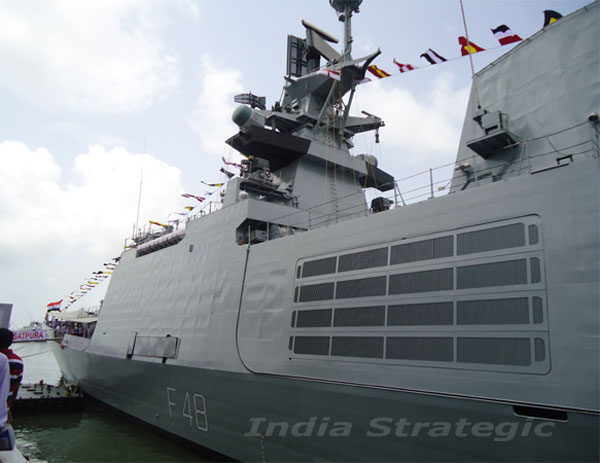
The two gas turbine engines LM-2500 are provided
by GE for blue water operations at 30 knots, and
two diesel engines, by French SEMT Pielstick,
for harbour and low speed operations.
Notably, it is only in the recent years that
India has started acquiring warship engines from
the US, and the same LM-2500 engines are also
being installed on board India’s three aircraft
carriers under construction or planned now. The
US Government allowed GE to sell them to India
only last year and four engines for the first
Indigenous Aircraft Carrier (IAC) have already
been acquired.
All the systems on board INS Satpura are controlled
electronically by computers from designated places
including the Ops Room, the heart of any warship.
Two Sea King or other helicopters would also
be stationed on board. However, the Indian Navy
is not using the HAL-made Dhruvs because of some
issues on their suitability on moving platforms.
Vice Adm Malhi said that most of the tests and
system checks had been completed by MDL before
handing over the warship.
He said he was particularly thankful to BEL (Bharat
Electronics Ltd.) for the EW systems support.
BEL Chairman and Managing Director, Mr Ashwani
Kumar Dutt, was among the dignitaries present
on the occasion.
According to an official statement, INS Satpura
is armed with a formidable array of surface, sub-surface
and air-defence weapons. These include long range
anti-ship missiles, anti-aircraft missiles and
anti-missile defence systems, which can detect
and engage the enemy at extended ranges, thereby
giving her significant combat power. The weapon-sensor
fit of the Satpura is controlled through a Combat
Management System, designed and developed by the
Indian Navy and manufactured by Bharat Electronics.
The system allows the seamless integration of
the ship’s systems as well as with the weapons
and sensors of other Fleet ships, thus enabling
the concept of ‘Co-operative Engagement Capability’
(CEC). The two multi-role helicopters that are
embarked on Satpura provide enhanced surveillance
and attack capability.
The Indian Navy’s Western Command has since
started the scheduled and extensive Weapon and
Missile firing and EW tests. Once these are executed
successfully, INS Satpura would be on its voyage
in the blue waters to defend the country.
It may be noted that according to Admiral Verma,
the Indian Navy has asked the ship builders to
complete most of the required tests before handing
over any vessel, so that the Navy has to conduct
only the weapon and systems checks. The Navy has
to go to the high seas, and ensure that there
are no ships in the test target areas, and there
is also a notification for other seamen (NOTAM
or Notice to Mariners) not to come near them.
According to the mandatory Form D448, which listed
various jobs completed by MDL, nearly 80 per cent
of the tests had been completed before INS Satpura
was handed over to the Indian Navy for the commissioning
ceremony.
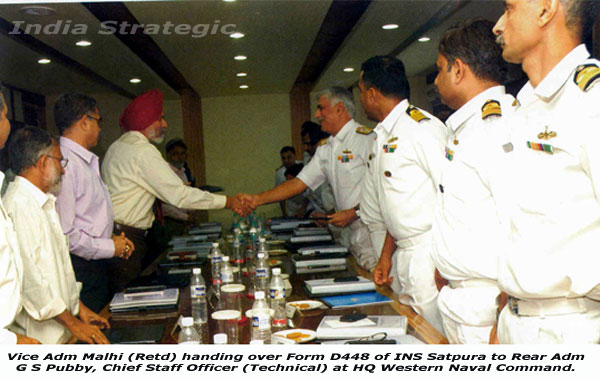
|